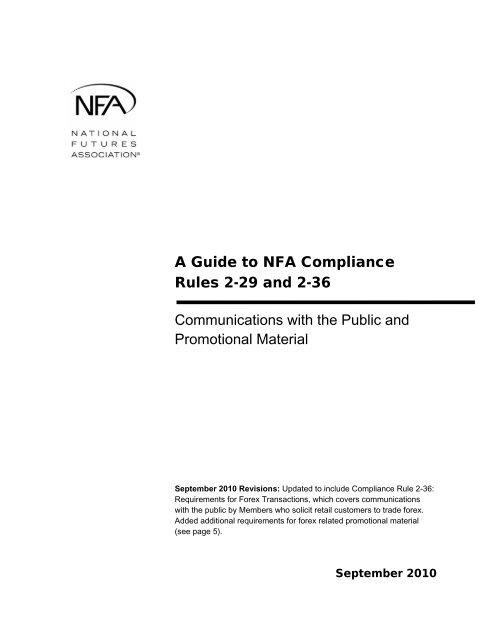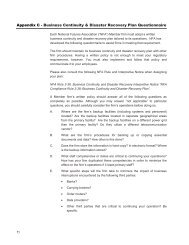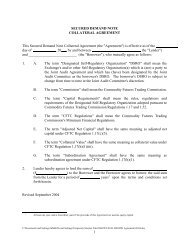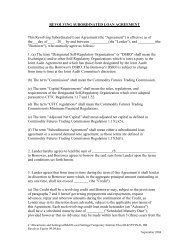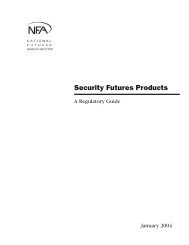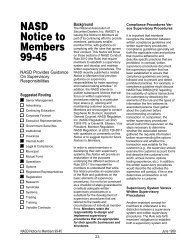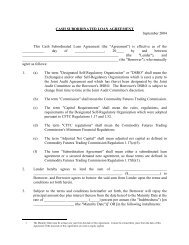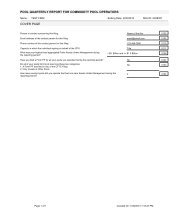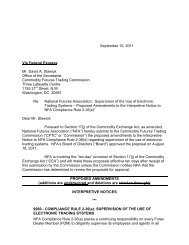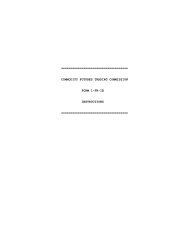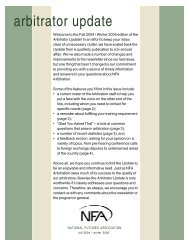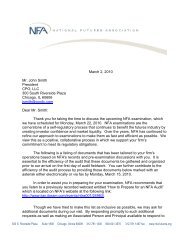A Guide To NFA Compliance Rules 2-29 - National Futures ...
A Guide To NFA Compliance Rules 2-29 - National Futures ...
A Guide To NFA Compliance Rules 2-29 - National Futures ...
Create successful ePaper yourself
Turn your PDF publications into a flip-book with our unique Google optimized e-Paper software.
A <strong>Guide</strong> to <strong>NFA</strong> <strong>Compliance</strong><br />
<strong>Rules</strong> 2-<strong>29</strong> and 2-36<br />
Communications with the Public and<br />
Promotional Material<br />
September 2010 Revisions: Updated to include <strong>Compliance</strong> Rule 2-36:<br />
Requirements for Forex Transactions, which covers communications<br />
with the public by Members who solicit retail customers to trade forex.<br />
Added additional requirements for forex related promotional material<br />
(see page 5).<br />
September 2010
Table of Contents<br />
Introduction and Purpose ...................................................................... 3<br />
Rule Provisions ....................................................................................... 4<br />
General Standards .................................................................................... 4<br />
Definition of Promotional Material ............................................................. 4<br />
Factual Statements ................................................................................... 4<br />
Statements of Opinion .............................................................................. 4<br />
Possibility of Profit ..................................................................................... 4<br />
Testimonials .............................................................................................. 5<br />
Hypothetical Results ................................................................................. 5<br />
Actual Past Trading Profits ....................................................................... 5<br />
Past Performance ..................................................................................... 5<br />
Additional Requirements for Forex related Promotional Material……….. 5<br />
Promotional Material for Security <strong>Futures</strong> Products ................................. 6<br />
Review and Approval of Promotional Material .......................................... 6<br />
General Standards .................................................................................. 8<br />
Deceptive and Misleading Communications ............................................. 8<br />
Use of High Pressure ................................................................................ 8<br />
Appropriateness of Trading ....................................................................... 9<br />
Content of Communication .................................................................. 10<br />
Balance Profit Potential with Risk of Loss .............................................. 10<br />
Statements of Opinion ............................................................................ 11<br />
Performance............................................................................................ 11<br />
Deceptive Communications .................................................................... 17<br />
Option-Related Communications ............................................................ 19<br />
Ratings and Rankings by Outside Sources ............................................ 21<br />
Security <strong>Futures</strong> Products ................................................................... 23<br />
Mandatory Requirements ........................................................................ 23<br />
Participation in a Trading Program ......................................................... 24<br />
Statistics and Charts ............................................................................... 24<br />
Past Trade Recommendations ............................................................... 24<br />
Current Trade Recommendations .......................................................... 25<br />
Correspondence ..................................................................................... 25<br />
Research Reports ................................................................................... 25<br />
Electronic Media ................................................................................... 27<br />
1
2<br />
Radio and Television Advertisements, Online Videos, Webinars and<br />
Podcasts ................................................................................................. 27<br />
Electronic Communications .................................................................... 28<br />
Websites ................................................................................................. <strong>29</strong><br />
Content Issues Specific to Electronic Communications ......................... 30<br />
Seminars ................................................................................................ 33<br />
Sales Training ....................................................................................... 34<br />
Responsibility for Promotional Material Produced by Others ......... 35<br />
Member Responsibility ............................................................................ 35<br />
Purchasing Leads ................................................................................... 35<br />
Article Reprints ........................................................................................ 35<br />
User-Generated Comments Related to Social Networking Groups…….36<br />
Review and Filing of Promotional Material Produced by Others ..... 37<br />
Mandatory Pre-Review ........................................................................... 37<br />
Voluntary Pre-Review Program .............................................................. 37<br />
Filing of Promotional Material ................................................................. 37<br />
General Questions about Promotional Material ...................................... 37<br />
Sources of Additional Information ...................................................... 38
Introduction and Purpose<br />
<strong>NFA</strong> <strong>Compliance</strong> <strong>Rules</strong> 2-<strong>29</strong> (“Rule 2-<strong>29</strong>”) and 2-36 ("Rule 2-36") deal<br />
with all forms of communication with the public by <strong>NFA</strong> Members or<br />
Associated Persons (“APs”). Rule 2-<strong>29</strong> covers communications with the<br />
public by Members who solicit customers to trade on-exchange futures<br />
and options on futures while Rule 2-36 covers communications with the<br />
public by Members who solicit retail customers to trade forex. The rules<br />
were drafted and approved by committees of <strong>NFA</strong> Members and were<br />
developed to ensure that Members observe the highest ethical standards<br />
when communicating with the public. However, the rules are not meant<br />
to stifle the use of fair and effective marketing tools. Both rules are<br />
continually interpreted by the <strong>NFA</strong>-Member Business Conduct<br />
Committee and <strong>NFA</strong>’s Hearing Committee (“Committees”).<br />
Since some of the rules' provisions are stated in general terms, Members<br />
may understandably seek more specific guidance on some points. The<br />
best source for that guidance can be found in the decisions <strong>NFA</strong>’s<br />
Committees have made in specific disciplinary cases and <strong>NFA</strong>’s<br />
Interpretive Notices.<br />
The purpose of this booklet is to provide <strong>NFA</strong> Members with additional<br />
guidance in preparing their promotional material. It outlines the major<br />
parameters of <strong>Rules</strong> 2-<strong>29</strong> and 2-36 and summarizes how <strong>NFA</strong>’s<br />
Committees have applied the rules to recurring fact patterns. The<br />
information set forth in this guide in not intended to be all-inclusive. It is<br />
important to note that more stringent guidelines will be imposed on those<br />
Members previously named in disciplinary actions and the individuals<br />
associated with such Members.<br />
3
Rule Provisions<br />
4<br />
General Standards<br />
• May not be deceptive or misleading;<br />
• May not use high-pressure sales tactics;<br />
• May not be part of a high-pressure approach; and<br />
• May not say or imply that futures or forex trading is appropriate<br />
for everyone<br />
Definition of Promotional Material<br />
• Sales or educational literature distributed to the public, whether<br />
prepared by the Member, its employees, other <strong>NFA</strong> Members, or<br />
non-Members;<br />
• Seminar presentations and any advertising designed to<br />
encourage attendance at such seminars;<br />
• Advertising; this includes newspapers, magazines, radio,<br />
television, and direct or electronic mail;<br />
• Standardized phone solicitations, including “cold calls”;<br />
• Newsletters, reports, circulars, etc.;<br />
• A prepared sales script, whether actually followed in making<br />
sales presentations or developed solely for training purposes;<br />
• Material used on the Internet; and<br />
• Hotlines.<br />
Factual Statements<br />
• Must be true; and<br />
• Members must be able to support the accuracy of each<br />
statement.<br />
Statements of Opinion<br />
• Must be identifiable as opinions; and<br />
• Must have a reasonable basis in fact.<br />
Possibility of Profit<br />
• Must be accompanied by an equally prominent statement of the<br />
risk of loss.
Testimonials<br />
• Must be representative of all reasonably comparable accounts;<br />
• Must prominently state that the testimonial is not indicative of<br />
future performance or success; and<br />
• Must prominently state that it is a paid testimonial (if applicable).<br />
Hypothetical Results<br />
• Cannot be presented for any trading program that has at least<br />
three months of actual client or proprietary trading results;<br />
• Must be accompanied by prescribed statements regarding<br />
hypothetical or simulated performance results;<br />
• Must include comparable information regarding the past<br />
performance of all customer accounts directed by the Member<br />
pursuant to a power of attorney or letter of direction over the<br />
past five years; and<br />
• If the Member has less than one year of experience directing<br />
customer accounts, past performance of the Member’s<br />
proprietary trading for the past five years must be included in the<br />
material.<br />
Actual Past Trading Profits<br />
• Must state that “Past results are not necessarily indicative of<br />
future results.”<br />
Past Performance<br />
• Rate of return figures must be calculated in a manner consistent<br />
with CFTC Regulation 4.25(a)(7)(i)(F) for commodity pools,<br />
CFTC Regulation 4.35(a)(6) and <strong>Compliance</strong> Rule 2-34(a) for<br />
figures based on separate accounts; and<br />
• Must be representative of the actual performance of all<br />
reasonably comparable accounts<br />
Additional Requirements for Forex related Promotional<br />
Material<br />
• No Member of Associate may represent that forex funds<br />
deposited with a Forex Dealer Member ("FDM") are given<br />
special protection under bankruptcy laws or represent or imply<br />
that any assets necessary to satisfy its obligations to customers<br />
are more secure because that Member keeps some of all of<br />
those assets at a regulated entity in the United States or a<br />
money center country.<br />
• No Member or Associate may represent that its services are<br />
commission free without prominently disclosing how it is<br />
compensated in near proximity to that representation.<br />
5
6<br />
• No Member or Associate may represent that it offers trading with<br />
"no-slippage" or that it guarantees the price at which a<br />
transaction will be executed or filled, unless:<br />
o It can demonstrate that all orders for all customers have<br />
been executed and fulfilled at the price initially quoted on<br />
the trading platform when the order was placed 1 ; and<br />
o No authority exists, pursuant to the contract, agreement,<br />
or otherwise, to adjust customer accounts in a manner<br />
that would have the direct or indirect effect of changing<br />
the price at which an order was executed. 2<br />
• Members and Associates may not solicit customers based on the<br />
leverage available unless they balance any discussion regarding<br />
the advantages of leverage with an equally prominent<br />
contemporaneous disclosure that increasing leverage increases<br />
risk.<br />
• Members and Associates may not represent that they can either<br />
guarantee against any customer losses or that they can<br />
guarantee only limited customer losses.<br />
Promotional Material for Security <strong>Futures</strong> Products<br />
In addition to complying with all of the above-mentioned provisions,<br />
promotional material for security futures products must adhere to<br />
numerous additional requirements. These requirements are discussed in<br />
detail, beginning on page 21.<br />
Review and Approval of Promotional Material<br />
• Members must have written supervisory procedures for<br />
promotional material produced and used by APs and employees.<br />
• Supervisory personnel must document the review and approval<br />
of all promotional material before it is used.<br />
• For forex-related promotional material, a supervisory employee<br />
that is, or is under the ultimate supervision of, a listed principal<br />
who is also an <strong>NFA</strong> Associate should review and approve all<br />
promotional material and make a written record of such review<br />
and approval.<br />
1 The FDM is not required to give the customer a price that is no longer reflected on the platform at the time the order reaches it. The FDM is<br />
not responsible for transmission delays outside its control. If FDM, however, advertises "no-slippage" or that it guarantees fill prices, it must<br />
prominently disclose that transmission delays might result in customer orders being executed at a price other than that seen by the customer.<br />
2 This includes force majeure provisions.
• If the material specifically refers to security futures products, the<br />
review and approval must be done by a designated securities<br />
futures principal.<br />
• Promotional material must be maintained on file for a period of<br />
five years from the date of last use and in a readily accessible<br />
location during the first two years of the five year period.<br />
Additional <strong>NFA</strong> References:<br />
<strong>NFA</strong> Interpretive Notice 9003: <strong>NFA</strong> <strong>Compliance</strong> Rule 2-<strong>29</strong>:<br />
Communications with the Public and Promotional Material (November<br />
1985)<br />
<strong>NFA</strong> Interpretive Notice 9009: <strong>NFA</strong> <strong>Compliance</strong> Rule 2-<strong>29</strong>: Review of<br />
Promotional Material Prior to its First Use (May 1989)<br />
<strong>NFA</strong> Interpretive Notice 9053: Forex Transactions<br />
7
General Standards<br />
8<br />
Deceptive and Misleading Communications<br />
Communications with the public may not be deceptive or misleading.<br />
This includes both day-to-day communications and promotional material.<br />
In general, day-to-day communications are spontaneous<br />
communications that respond to a particular person’s needs and<br />
concerns, while promotional material is prepared or thought out in<br />
advance. A communication may be deceptive or misleading even if no<br />
customer or potential customer is actually deceived.<br />
Whether a communication is deceptive or misleading depends on the<br />
content and the overall impression it makes, regardless of whether it is a<br />
day-to-day communication or promotional material. Statements that are<br />
deceptive in promotional material are generally deceptive in day-to-day<br />
communications as well. However, the standards for holding a Member<br />
or Associate responsible for those statements are different for the two<br />
types of communications.<br />
• A Member or Associate is held responsible for deceptive and<br />
misleading statements in day-to-day communications if the<br />
Member or Associate intended to mislead or made the<br />
statement recklessly. <strong>NFA</strong>’s Committees have consistently<br />
found that Members and Associates act recklessly when they<br />
make statements that they should know are false or<br />
misleading.<br />
• A different standard applies for promotional material because<br />
the Member or Associate has the opportunity to think about the<br />
content before using the material. A Member or Associate can<br />
be held responsible if it should have reasonably been able to<br />
determine that the promotional material is likely to deceive the<br />
public. This means that a Member or Associate must conduct a<br />
reasonable inquiry into any affirmative statements and must<br />
review the overall impact of the promotional material. A<br />
Member or Associate can also be held responsible for factual<br />
omissions if the Member or Associate knew about the omitted<br />
fact and the omission makes the promotional material<br />
misleading.<br />
Use of High Pressure<br />
Members and Associates may not use high-pressure sales tactics or<br />
make communications that are part of a high-pressure sales approach.<br />
The following are some, but not all, of the tactics that <strong>NFA</strong> Committees<br />
have found to involve high pressure:
• An AP rushing a customer through account opening forms and<br />
glossing over the risk disclosure in haste to open the account;<br />
• An overnight courier service delivering blank account forms to<br />
the customer and waiting while the customer completes the<br />
forms;<br />
• An AP actively attempting to dissuade unsophisticated<br />
customers from seeking further advice on their investment<br />
decisions;<br />
• Threatening or intimidating customers; and<br />
• Phone calls made at unusual hours and with unusual frequency,<br />
which annoy and harass a customer into opening an account.<br />
Appropriateness of Trading<br />
Communications with the public may not state or imply that futures<br />
trading is appropriate for everyone. <strong>NFA</strong> Committees have found that<br />
using testimonials from unsophisticated customers, stating “anyone can<br />
do it, my mother can do it,” and calling trades “no-brainers” violate this<br />
provision.<br />
Additional <strong>NFA</strong> References:<br />
<strong>NFA</strong> Interpretive Notice 9003: <strong>NFA</strong> <strong>Compliance</strong> Rule 2-<strong>29</strong>:<br />
Communications with the Public and Promotional Material (Revised July<br />
2000)<br />
<strong>NFA</strong> Interpretive Notice 9038: <strong>NFA</strong> <strong>Compliance</strong> Rule 2-<strong>29</strong>: High<br />
Pressure Sales Tactics (June 1996)<br />
9
Content of Communication<br />
10<br />
Balance Profit Potential with Risk of Loss<br />
<strong>NFA</strong> <strong>Compliance</strong> <strong>Rules</strong> 2-<strong>29</strong> and 2-36 require any mention of the<br />
possibility of profit to be accompanied by an equally prominent statement<br />
of the risk of loss. The rule requires that profit and loss be emphasized<br />
proportionately.<br />
In addition, when Members and Associates solicit customers to trade<br />
forex, they may not solicit based on the leverage available unless they<br />
balance any discussion regarding leverage with an equally prominent<br />
contemporaneous disclosure that increasing leverage increases risk.<br />
A discussion of profit may take many forms, including:<br />
• Past performance results;<br />
• Graphs depicting the growth of an account;<br />
• Discussion of opportunity; and<br />
• Statements that imply or infer profit.<br />
Evaluating balance requires a Member to analyze the overall piece.<br />
These factors may be a part of the final determination, so Members<br />
should consider them when developing promotional material.<br />
• Font size of the risk disclaimer vs. the remainder of the text; a<br />
risk disclaimer that is not as prominent as the rest of the text may<br />
be viewed as downplaying the risk of loss.<br />
• The number of times profit is addressed vs. the number of times<br />
risk of loss is addressed; a five page piece of promotional<br />
material that contains several references to profit potential or<br />
opportunity with only one risk statement at the bottom of each<br />
page may be considered unbalanced.<br />
• The manner in which risk is addressed; a risk disclaimer must<br />
address the significant risk of loss that is unique to the futures<br />
industry. “Commodity Trading Involves Substantial Risk of Loss”<br />
is an appropriate disclaimer, whereas “All Trading Involves Risk”<br />
is not as it fails to address the risk of loss that is unique to this<br />
industry. Furthermore, the discussion addressing risk should<br />
stand alone and should not include qualifiers. For example, the<br />
following disclaimer is not acceptable, “Commodity trading<br />
involves substantial risk of loss. However, it is less risky than<br />
investing in swaps.”
On the other hand, it is not enough to make sure that the font sizes are<br />
the same or that the material contains the same number of references to<br />
profit and loss. For example, a piece of promotional material that<br />
contains five references to extremely large profits is not balanced by five<br />
references to the fact that there is some risk. Furthermore, merely<br />
including the required performance disclaimer “Past results are not<br />
necessarily indicative of future results” may not suffice in balancing<br />
promotional material that discusses actual or potential profits.<br />
Statements of Opinion<br />
Statements of opinion may be included in promotional material as long<br />
as the following criteria are met:<br />
• Statements are clearly identified as opinions; and<br />
• Members are able to support that their opinions have a<br />
reasonable basis in fact.<br />
The extent of the support required depends on the nature of the opinion.<br />
Certain opinions by their nature may not be susceptible to ironclad<br />
documentation, but Members should always be able to demonstrate at<br />
least a reasonable basis for their claims.<br />
Performance<br />
Use of Past Results<br />
Members often use their clients’ past trading results to demonstrate the<br />
effectiveness of a trading strategy or program. Use of this information is<br />
generally acceptable as long as the following guidelines are met:<br />
• Performance is representative of all customer accounts.<br />
• Full disclosure is made about the results. For example,<br />
• References to such things as “average rate of return”<br />
generally require a significant amount of disclosure; and<br />
• Presenting an “average” or “cumulative” return when the<br />
individual returns for the period have wide fluctuations is<br />
considered misleading.<br />
• The disclaimer, “Past results are not necessarily indicative of<br />
future results” immediately precedes or follows the performance<br />
data.<br />
• The material is balanced with regard to the risk of loss involved<br />
in trading futures and options.<br />
• The material does not omit information that would render the<br />
performance data misleading.<br />
11
12<br />
• The material discloses all relevant costs, including commissions,<br />
pip spreads and fees.<br />
Annual Rates of Return<br />
<strong>NFA</strong> <strong>Compliance</strong> <strong>Rules</strong> 2-<strong>29</strong>, 2-36 and their related Interpretive Notices<br />
require annual rate of return figures to be calculated in a manner<br />
consistent with CFTC regulations:<br />
• Rate of return should be based on 12 consecutive months of<br />
performance;<br />
• Rate of return should be computed on a compounded monthly<br />
basis; and<br />
• Rate of return should be calculated by dividing net performance<br />
by beginning net asset value.<br />
The CFTC allows three variations of this method. These variations are:<br />
• Time Weighting for Additions and Withdrawals;<br />
• Only Accounts Traded; and<br />
• Compounded Rate of Return.<br />
Each of these alternative methods is fully explained in Appendix B to<br />
Part 4 of the CFTC's regulations or <strong>NFA</strong> Interpretive Notice titled<br />
"<strong>Compliance</strong> Rule 2-34: Performance Reporting and Disclosures."<br />
Members should select the method that most accurately depicts client<br />
performance. Furthermore, once a method is selected, it should be used<br />
consistently unless it produces misleading results.<br />
Extracted Performance<br />
Extracted performance, in which a Member highlights the performance of<br />
one component of a trading program, is only permitted in the following<br />
circumstances:<br />
• A CPO’s or CTA’s disclosure document designates the specific<br />
percentage of assets committed to the component being<br />
highlighted (i.e., if a pool’s disclosure document states that 25<br />
percent of the fund’s assets are dedicated to trading financial<br />
futures, the CPO may present the extracted performance of the<br />
financial futures).<br />
• Extracted results are adequately labeled as such.<br />
• Trading results of the overall program are disclosed in an equally<br />
prominent manner.
Pro-forma Performance<br />
Pro-forma performance is performance that has been adjusted to<br />
account for the commissions and fees the Member charges. (Members<br />
who charge negotiable fees should use the maximum fees possible<br />
when presenting pro-forma performance.) The following performance<br />
should be presented pro-forma:<br />
• Proprietary performance<br />
• Performance for client accounts that were charged less than<br />
standard fees.<br />
Hypothetical Performance<br />
<strong>NFA</strong> <strong>Compliance</strong> Rule 2-<strong>29</strong> (as well as <strong>Compliance</strong> Rule 2-36(i), which<br />
requires that Members and Associates who solicit customers to trade<br />
forex comply with <strong>Compliance</strong> Rule 2-<strong>29</strong>(c)) and the interpretive notice<br />
regarding the use of hypothetical performance results have specific<br />
requirements for material that contains hypothetical data. The purpose<br />
of these requirements is to ensure that the audience realizes the results<br />
are in fact hypothetical and therefore have significant limitations that<br />
should be considered.<br />
<strong>NFA</strong> considers the following data to be hypothetical:<br />
• A trade or series of trades that were not actually executed for<br />
one account,<br />
• Paper or simulated trading,<br />
• Combining the performance of several advisors who have not<br />
traded together, and<br />
• Applying arithmetic calculations to actual performance.<br />
It is misleading to refer to results as “real-time” simply because a system<br />
was tested using a live data-feed. Similarly, it is misleading to refer to<br />
hypothetical results as “pro-forma.” These results should be prominently<br />
labeled “Hypothetical” and should adhere to all of the hypothetical<br />
requirements.<br />
Members who use hypothetical performance results must comply with<br />
the following requirements:<br />
• Hypothetical results must be adequately labeled as hypothetical.<br />
• Hypothetical performance should be calculated the same way as<br />
actual performance.<br />
13
14<br />
• Members must be able to demonstrate the basis for the<br />
hypothetical results and the underlying theory that generated<br />
them.<br />
The following requirements also apply unless the promotional material is<br />
directed exclusively to “Qualified Eligible Persons,” as defined in CFTC<br />
Regulation 4.7:<br />
• Hypothetical results may not be used for any trading program<br />
that has at least three months of actual client or proprietary<br />
performance.<br />
• Members who elect to disclose hypothetical performance for a<br />
new trading program must be able to demonstrate that the<br />
program is significantly different from other programs with actual<br />
results.<br />
• The actual past performance of all accounts directed by the<br />
Member pursuant to a power of attorney over the past five years<br />
must be included in the material.<br />
• If a Member has less than one year of experience directing client<br />
accounts, past performance of all proprietary accounts for the<br />
last five years must be included in the material.<br />
• The material must include a discussion of all of the assumptions<br />
that were made in preparing the hypothetical results. Such<br />
assumptions include:<br />
o Initial investment amount;<br />
o Whether profits were reinvested or distributed;<br />
o Commissions and fees that were charged; and<br />
o The method used to determine purchase and sales<br />
prices for each hypothetical transaction.<br />
• The following disclaimers should immediately precede or follow<br />
hypothetical performance results:<br />
HYPOTHETICAL PERFORMANCE RESULTS HAVE MANY<br />
INHERENT LIMITATIONS, SOME OF WHICH ARE<br />
DESCRIBED BELOW. NO REPRESENTATION IS BEING<br />
MADE THAT ANY ACCOUNT WILL OR IS LIKELY TO<br />
ACHIEVE PROFITS OR LOSSES SIMILAR TO THOSE<br />
SHOWN. IN FACT, THERE ARE FREQUENTLY SHARP<br />
DIFFERENCES BETWEEN HYPOTHETICAL PERFORMANCE<br />
RESULTS AND THE ACTUAL RESULTS SUBSEQUENTLY<br />
ACHIEVED BY ANY PARTICULAR TRADING PROGRAM.
ONE OF THE LIMITATIONS OF HYPOTHETICAL<br />
PERFORMANCE RESULTS IS THAT THEY ARE GENERALLY<br />
PREPARED WITH THE BENEFIT OF HINDSIGHT. IN<br />
ADDITION, HYPOTHETICAL TRADING DOES NOT INVOLVE<br />
FINANCIAL RISK, AND NO HYPOTHETICAL TRADING<br />
RECORD CAN COMPLETELY ACCOUNT FOR THE IMPACT<br />
OF FINANCIAL RISK IN ACTUAL TRADING. FOR EXAMPLE,<br />
THE ABILITY TO WITHSTAND LOSSES OR ADHERE TO A<br />
PARTICULAR TRADING PROGRAM IN SPITE OF TRADING<br />
LOSSES ARE MATERIAL POINTS WHICH CAN ALSO<br />
ADVERSELY AFFECT ACTUAL TRADING RESULTS. THERE<br />
ARE NUMEROUS OTHER FACTORS RELATED TO THE<br />
MARKETS IN GENERAL OR TO THE IMPLEMENTATION OF<br />
ANY SPECIFIC TRADING PROGRAM WHICH<br />
CANNOT BE FULLY ACCOUNTED FOR IN THE<br />
PREPARATION OF HYPOTHETICAL PERFORMANCE<br />
RESULTS AND ALL OF WHICH CAN ADVERSELY AFFECT<br />
ACTUAL TRADING RESULTS.<br />
Members who have less than one year of experience trading<br />
client or proprietary accounts must also include this statement:<br />
(THE MEMBER) HAS HAD LITTLE OR NO EXPERIENCE IN<br />
TRADING ACTUAL ACCOUNTS FOR ITSELF OF FOR<br />
CUSTOMERS. BECAUSE THERE ARE (LITTLE OR) NO<br />
ACTUAL TRADING RESULTS TO COMPARE TO THE<br />
HYPOTHETICAL RESULTS, CUSTOMERS SHOULD BE<br />
PARTICULARLY WARY OF PLACING UNDUE RELIANCE ON<br />
THESE HYPOTHETICAL PERFORMANCE RESULTS.<br />
• However, Members who use hypothetical performance records<br />
which show what a multi-advisor account or pool could have<br />
achieved if assets had been allocated among certain advisors<br />
should replace the above disclaimer with the following:<br />
THIS COMPOSITE PERFORMANCE RECORD IS<br />
HYPOTHETICAL AND THESE TRADING ADVISORS HAVE<br />
NOT TRADED TOGETHER IN THE MANNER SHOWN IN THE<br />
COMPOSITE. HYPOTHETICAL PERFORMANCE RESULTS<br />
HAVE MANY INHERENT LIMITATIONS, SOME OF WHICH<br />
ARE DESCRIBED BELOW. NO REPRESENTATION IS BEING<br />
MADE THAT ANY MULTI-ADVISOR MANAGED ACCOUNT<br />
OR POOL WILL OR IS LIKELY TO ACHIEVE A COMPOSITE<br />
PERFORMANCE RECORD SIMILAR TO THAT SHOWN. IN<br />
FACT, THERE ARE FREQUENTLY SHARP DIFFERENCES<br />
15
16<br />
BETWEEN A HYPOTHETICAL COMPOSITE RECORD AND<br />
THE ACTUAL RECORD SUBSEQUENTLY ACHIEVED.<br />
ONE OF THE LIMITATIONS OF A HYPOTHETICAL<br />
COMPOSITE PERFORMANCE RECORD IS THAT DECISIONS<br />
RELATING TO THE SELECTION OF TRADING ADVISORS<br />
AND THE ALLOCATION OF ASSETS AMONG THOSE<br />
TRADING ADVISORS WERE MADE WITH THE BENEFIT OF<br />
HINDSIGHT BASED UPON THE HISTORICAL RATES OF<br />
RETURN OF THE SELECTED TRADING ADVISORS.<br />
THEREFORE COMPOSITE PERFORMANCE RECORDS<br />
INVARIABLY SHOW POSITIVE RATES OF RETURN.<br />
ANOTHER INHERENT LIMITATION ON THESE RESULTS IS<br />
THAT THE ALLOCATION DECISIONS REFLECTED IN THE<br />
PERFORMANCE RECORD WERE NOT MADE UNDER<br />
ACTUAL MARKET CONDITIONS AND THEREFORE,<br />
CANNOT COMPLETELY ACCOUNT FOR THE IMPACT OF<br />
FINANCIAL RISK IN ACTUAL TRADING. FURTHERMORE,<br />
THE COMPOSITE PERFORMANCE RECORD MAY BE<br />
DISTORTED BECAUSE THE ALLOCATION OF ASSETS<br />
CHANGES FROM TIME TO TIME AND THESE<br />
ADJUSTMENTS ARE NOT REFLECTED IN THE COMPOSITE.<br />
Furthermore, if the Member has less than one year of experience<br />
allocating assets among particular trading advisors, then the<br />
disclaimer must also contain the following statement:<br />
(THE MEMBER) HAS HAD LITTLE OR NO EXPERIENCE<br />
ALLOCATING ASSETS AMONG PARTICULAR TRADING<br />
ADVISORS. BECAUSE THERE ARE (LITTLE OR) NO<br />
ACTUAL ALLOCATIONS TO COMPARE TO THE<br />
PERFORMANCE RESULTS FROM THE HYPOTHETICAL<br />
ALLOCATION, CUSTOMERS SHOULD BE PARTICULARLY<br />
WARY OF PLACING UNDUE RELIANCE ON THESE<br />
RESULTS.<br />
Additional <strong>NFA</strong> References:<br />
<strong>NFA</strong> Interpretive Notices: 9025: <strong>NFA</strong> <strong>Compliance</strong> Rule 2-<strong>29</strong>: Use of<br />
Promotional Material Containing Hypothetical Performance Results<br />
<strong>NFA</strong> Notice to Members: I-96-20: Amendments to <strong>NFA</strong> <strong>Compliance</strong> Rule<br />
2-<strong>29</strong>(c) and the Interpretive Notice Relating to the Use of Promotional<br />
Material Containing Hypothetical Performance Results
Deceptive Communications<br />
The following practices can be highly misleading, and may only be used<br />
if Members are able to demonstrate that, based on the actual<br />
performance of their customers, the claims they are making are not<br />
misleading.<br />
Proprietary Accounts<br />
Members who disclose the past performance of their personal trading<br />
accounts should also comply with the following:<br />
• Proprietary performance data should not be combined with client<br />
performance data;<br />
• The results must be adequately labeled as proprietary;<br />
• The results should be adjusted to reflect the commissions and<br />
fees that clients will incur; and<br />
• Any differences between proprietary trading and client trading<br />
must be fully explained.<br />
Profit Projections<br />
Statements such as, “turn $10,000 into $40,000” are misleading unless<br />
the Member or Associate can demonstrate to <strong>NFA</strong> that this is<br />
representative of its overall customer performance.<br />
Leverage Examples<br />
Many Members use examples to demonstrate the leverage that is<br />
available in futures and options trading. Promotional material that utilizes<br />
the term “leverage” must include a thorough discussion of the<br />
relationship between margin and the product being traded.<br />
In addition, the following guidelines should be considered when using<br />
leverage examples:<br />
• Using option-related leverage examples to promote long options,<br />
when a Member’s customer base does not routinely exercise<br />
options, is misleading.<br />
• Using leverage examples, that suggest that prospective<br />
customers are likely to earn large profits is considered<br />
misleading, when past performance does not support this claim.<br />
• Including disclaimers which indicate that the examples are<br />
mathematical in nature and are not intended to imply that<br />
customers have achieved or may achieve similar results, will still<br />
be considered misleading if the thrust of the ad conveys the<br />
opposite message.<br />
17
18<br />
Claims Regarding Seasonal Trades<br />
Some Members utilize promotional material which emphasizes that the<br />
seasonal nature of supply and demand drives prices higher or lower.<br />
These discussions can be misleading and violate <strong>NFA</strong> <strong>Compliance</strong> <strong>Rules</strong><br />
2-<strong>29</strong> and 2-36 when:<br />
• They fail to mention that futures prices have already factored in<br />
the seasonal aspects of supply and demand;<br />
• The presentation implies that all you have to do is be in the<br />
market at the right time to reap the benefits of the supply and<br />
demand fundamentals;<br />
• The communication cites historic data which appears to<br />
demonstrate that certain trades produce dramatic profits year in<br />
and year out; or<br />
• The Member’s customers have not experienced the types of<br />
profits touted in the material.<br />
Claims Using Historic Price Moves or Outdated Information<br />
Communications that include a record-setting historic price move with a<br />
suggestion that the same record-setting move is likely to occur again are<br />
misleading. By suggesting that a similar move is imminent, the Member<br />
misguides customers into thinking they can double, triple or quadruple<br />
their investments in a short period of time.<br />
The following practices are also misleading:<br />
• Using historic data for products other than the one being<br />
marketed (e.g., using data from the cash market to sell futures or<br />
from an at-the-money option to sell out-of-the-money options);<br />
• Using historic data for the same product if the information does<br />
not include commissions and fees comparable to those charged<br />
by the Member; and<br />
• Suggesting that a significant price move is a conservative move.<br />
Members also should avoid using outdated information to support current<br />
claims. The practice of suggesting that such outdated information is<br />
relevant, given current market conditions, is highly misleading.<br />
Cherry Picking<br />
Cherry Picking is the process of highlighting the performance of isolated<br />
accounts or isolated trades within an account. This practice can be highly<br />
misleading. Therefore:
• Members may not present the performance of one particular<br />
account unless that performance is representative of the<br />
Member’s overall customer performance.<br />
• Similarly, Members may not present performance of specific<br />
trades within an account unless those returns are representative<br />
of the account’s overall performance.<br />
Testimonials<br />
Many members utilize client testimonials which constitute cherry picking.<br />
A testimonial will violate <strong>NFA</strong> <strong>Compliance</strong> <strong>Rules</strong> 2-<strong>29</strong> and 2-36 if the<br />
testimonial contains performance claims that are not representative of<br />
the Member’s overall customer performance or not representative of how<br />
that customer account performed overall.<br />
In addition, a testimonial must:<br />
• Prominently state that the testimonial is not indicative of future<br />
success and<br />
• Prominently state that it is a paid testimonial (if applicable)<br />
Additional <strong>NFA</strong> References:<br />
<strong>NFA</strong> Interpretive Notice: 9033: <strong>NFA</strong> <strong>Compliance</strong> Rule 2-<strong>29</strong>: Deceptive<br />
Advertising<br />
<strong>NFA</strong> Interpretive Notice 9034: <strong>NFA</strong> <strong>Compliance</strong> Rule 2-<strong>29</strong>: Deceptive<br />
Advertising<br />
Option-Related Communications<br />
Long Options<br />
Communications that indicate option trading involves:<br />
• Limited risk or<br />
• No margin calls<br />
will be considered misleading unless it adequately discloses that such<br />
characteristics apply to long options only. Furthermore, the<br />
communication should clearly disclose that the “limited risk” includes the<br />
premium paid on the option, plus commissions and fees.<br />
Using the term “limited risk” to imply that the likelihood of loss is limited is<br />
highly misleading. Any discussion of limited risk must make it clear that<br />
the term refers to the amount of the loss but not the likelihood of loss.<br />
Short Options<br />
Conversely, promotional material that solicits for short options should<br />
adequately disclose that sellers are:<br />
19
20<br />
• Subject to margin calls and<br />
• Exposed to virtually unlimited risk.<br />
Price Data and Price Charts<br />
Examples of option-related communications that <strong>NFA</strong> considers<br />
misleading include communications that:<br />
• Use cash, futures-market or forex data to sell options, e.g.,<br />
• Option-related promotional material should generally not<br />
include futures or forex price charts unless accompanied by<br />
option price charts, and<br />
• Members must ensure that the futures, options and forex<br />
charts mirror the same time period;<br />
• Imply that options prices move in tandem with cash, futures<br />
or forex prices;<br />
• Use price data for at-the-money options to sell out-of-the<br />
money options; or<br />
• Use price data that does not include commissions and fees<br />
comparable to those charged by the Member.<br />
While including price data or price charts for products other than<br />
the product being marketed can add some value to promotional<br />
material, this data should be shown:<br />
• In an educational manner only and<br />
• With a complete discussion of the relationship between the<br />
different products.<br />
The following is a sample disclaimer that adequately addresses<br />
these issues:<br />
FOR CUSTOMERS TRADING OPTIONS, THESE FUTURES<br />
AND FOREX CHARTS ARE PRESENTED FOR<br />
INFORMATIONAL PURPOSES ONLY. THEY ARE<br />
INTENDED TO SHOW HOW INVESTING IN OPTIONS CAN<br />
DEPEND ON THE UNDERLYING FUTURES PRICES;<br />
SPECIFICALLY, WHETHER OR NOT AN OPTION<br />
PURCHASER IS BUYING AN IN-THE-MONEY, AT-THE-<br />
MONEY, OR OUT-OF-THE-MONEY OPTION.<br />
FURTHERMORE, THE PURCHASER WILL BE ABLE TO<br />
DETERMINE WHETHER OR NOT TO EXERCISE HIS RIGHT<br />
ON AN OPTION DEPENDING ON HOW THE OPTION’S<br />
STRIKE PRICE COMPARES TO THE UNDERLYING<br />
FUTURE’S PRICE. THE FUTURES CHARTS ARE NOT
INTENDED TO IMPLY THAT OPTION PRICES MOVE IN<br />
TANDEM WITH FUTURES PRICES. IN FACT, OPTION<br />
PRICES MAY ONLY MOVE A FRACTION OF THE PRICE<br />
MOVE IN THE UNDERLYING FUTURES. IN SOME CASES,<br />
THE OPTION MAY NOT MOVE AT ALL OR EVEN MOVE IN<br />
THE OPPOSITE DIRECTION OF THE UNDERLYING<br />
FUTURES CONTRACT.<br />
Additional <strong>NFA</strong> References:<br />
<strong>NFA</strong> Interpretive Notice 9034: <strong>NFA</strong> <strong>Compliance</strong> Rule 2-<strong>29</strong>: Deceptive<br />
Advertising<br />
Ratings and Rankings by Outside Sources<br />
There are a number of magazines, newsletters and other services which<br />
evaluate, rate or rank the performance of managed accounts and pools.<br />
A Member utilizing these ratings or rankings must:<br />
• Ensure proper disclosure is made about the basis and<br />
limitations of such ratings/rankings. Examples of possible<br />
disclosures include:<br />
• “only advisors or pool operators that submitted their<br />
performance data were rated,”<br />
• “only advisors with $________ under management were<br />
rated,”<br />
• “only public pools were considered,” or<br />
• “only ____ number of entrants participated in the contest.”<br />
• Be able to demonstrate that all rate of return calculations, even<br />
those of outside rating services, are calculated in a manner<br />
consistent with CFTC Regulation 4.25(a)(7)(i)(f), CFTC<br />
Regulation 4.35(a)(6) and <strong>Compliance</strong> Rule 2-34(c) as<br />
applicable.<br />
• Have all of the necessary data available to support performance<br />
results and other numeric information.<br />
• Ensure that the ratings or results are balanced with an equally<br />
prominent discussion of the risk of loss.<br />
• Include the disclaimer: “Past results are not necessarily<br />
indicative of future results.”<br />
A Member cannot state or imply that the ratings or rankings presented<br />
are officially sanctioned by the futures industry.<br />
21
22<br />
Trading Championships<br />
Members who participate in trading championships may only promote<br />
their performance results if full disclosure is made of all material<br />
differences between the program followed in the contest and the<br />
program being used to trade customer accounts. Examples of such<br />
differences include:<br />
• Markets traded,<br />
• Leverage used,<br />
• Margin rates, and<br />
• Commissions and fees.
Security <strong>Futures</strong> Products<br />
<strong>Compliance</strong> Rule 2-<strong>29</strong>(j) applies to promotional material that specifically<br />
refers to security futures products. (Please note that this section of 2-<strong>29</strong><br />
does not pertain to promotional material whose only reference to security<br />
futures products is in a listing of the firm’s services.)<br />
<strong>Compliance</strong> Rule 2-<strong>29</strong>(j) is applicable to material used by <strong>NFA</strong> Member<br />
FCMs and IBs who have notice registered as broker-dealers and their<br />
Associates. <strong>NFA</strong>’s rules regarding security futures products are quite<br />
extensive. As such, an overview of <strong>Compliance</strong> Rule 2-<strong>29</strong>(j) follows.<br />
Mandatory Requirements<br />
All promotional material for security futures products must adhere to the<br />
following:<br />
• Must prominently identify the Member;<br />
• Must include the date the material was first used;<br />
• Must state that security futures products are not suitable for all<br />
customers;<br />
• Must be reviewed and approved in writing, by a designated<br />
security futures principal prior to first use;<br />
• Must be accompanied by or preceded by the disclosure<br />
statement for security futures products. This requirement does<br />
not apply to generic promotional material for security futures<br />
products if the material includes contact information for obtaining<br />
a copy of the required disclosure statement.<br />
• Promotional material designed to reach a public audience<br />
through the mass media must be submitted to <strong>NFA</strong> for review<br />
and approval at least ten days prior to first use.<br />
Promotional material for security futures products cannot:<br />
• Include a statement suggesting that security futures positions<br />
can be liquidated at any time; or<br />
• Include a cautionary statement, caveat, or disclaimer that is not<br />
legible, that attempts to disclaim responsibility for the content of<br />
the promotional material or the opinions expressed in the<br />
material, that is misleading, or that is otherwise inconsistent with<br />
the content of the material.<br />
In addition to the various general requirements, promotional material that<br />
incorporates any of the following topics must adhere to the additional<br />
requirements discussed below.<br />
23
24<br />
Participation in a Trading Program<br />
FCMs and IBs who use promotional material to solicit for trading<br />
programs that include security futures products must disclose the<br />
following:<br />
• The cumulative past performance of all of the Member’s<br />
customers who have traded the program. The past performance<br />
data must comply with the following requirements:<br />
• Performance must be calculated in a manner consistent with<br />
CFTC Regulation 4.25(a)(7)(i)(F);<br />
• Members and Associates must maintain records showing<br />
how the performance was calculated; and<br />
• A designated security futures principal must determine that<br />
the performance data is accurate and representative of all<br />
reasonably comparable accounts.<br />
• If the Member does not have any customers who have traded<br />
the program, the promotional material must state that the trading<br />
program is unproven and must include all of the information<br />
required by section (c) of <strong>Compliance</strong> Rule 2-<strong>29</strong>.<br />
Statistics and Charts<br />
Promotional material that incorporates charts and statistics regarding<br />
security futures products must adhere to the following:<br />
• Must disclose the source of any statistical data or illustrations,<br />
unless otherwise obvious; and<br />
• Must state that supporting documentation will be furnished upon<br />
request for all claims, comparisons, recommendations, statistics<br />
or other technical data.<br />
Past Trade Recommendations<br />
A Member may not use promotional material that refers to past trade<br />
recommendations in security futures products, the underlying securities,<br />
or derivatives thereof unless the promotional material describes all other<br />
recommendations made for similar products (e.g. type, kind, grade or<br />
classification of securities) over the past year. The following information<br />
must be disclosed:<br />
• The name of each security recommended;<br />
• The date of each recommendation;<br />
• The specific nature of each recommendation (e.g., buy/sell, limit<br />
order, GTC);<br />
• The price at the time of the recommendation;
• The price or price range within which the recommendation was<br />
to be acted upon;<br />
• The date and price at the end of the recommendation period, or<br />
when liquidation was suggested; and<br />
• The general market conditions during the period covered.<br />
Current Trade Recommendations<br />
Promotional material that includes specific trade recommendations for<br />
security futures products must adhere to the following guidelines:<br />
• The Member must have a reasonable basis for the<br />
recommendation;<br />
• The material must disclose all material conflicts of interest<br />
created by the Member’s activities in the underlying security; and<br />
• The material must contain contact information for obtaining the<br />
list of prior recommendations described above.<br />
Correspondence<br />
Not all written correspondence is promotional material under <strong>NFA</strong><br />
<strong>Compliance</strong> Rule 2-<strong>29</strong>. However all correspondence involving security<br />
futures products must comply with the interpretive notice entitled, “<strong>NFA</strong><br />
<strong>Compliance</strong> Rule 2-9: Supervisory Procedures for E-mail and the use of<br />
Web Sites.” (See the “Electronic Media-E-mail and Web Site” discussion<br />
for details.)<br />
Additional requirements also apply. In particular:<br />
• The Member must retain a copy of the correspondence.<br />
• The name of the person who prepared the correspondence must<br />
be ascertainable from the retained record.<br />
• The firm’s written supervisory procedures must require that a<br />
designated security futures principal review correspondence<br />
relating to security futures products.<br />
Research Reports<br />
Research reports for the underlying securities are not considered<br />
promotional material under <strong>NFA</strong> <strong>Compliance</strong> Rule 2-<strong>29</strong>. However,<br />
research reports that mention security futures products or strategies that<br />
include them are considered promotional material and, therefore, must<br />
fully comply with the rule.<br />
25
26<br />
Additional <strong>NFA</strong> References:<br />
<strong>NFA</strong> Interpretive Notices 9043: <strong>NFA</strong> <strong>Compliance</strong> Rule 2-<strong>29</strong>: Use of Past<br />
or Projected Performance; Disclosing Conflicts of Interest for Security<br />
<strong>Futures</strong> Products
Electronic Media<br />
Radio and Television Advertisements, Online Videos,<br />
Webinars and Podcasts<br />
Members who use or directly benefit from radio or television<br />
advertisements or any other audio or video advertisement distributed<br />
through media accessible by the public that makes specific trade<br />
recommendations or references to past or potential profits are required<br />
to submit the advertisements to <strong>NFA</strong> for review and approval at least ten<br />
(10) days prior to use. 3<br />
An electronic advertisement must be pre-approved if:<br />
• The advertisement highlights particular markets more than<br />
others;<br />
• The advertisement provides an opinion regarding the anticipated<br />
direction of a particular market or markets;<br />
• The advertisement represents that a potential opportunity exists<br />
in a particular market or markets regardless of whether the<br />
discussion is purely subjective or based upon factual data; or<br />
• The advertisement provides the implication of opportunity<br />
through the use of adjectives such as “hot” or “explosive.”<br />
Characteristics that would not, by themselves, require an advertisement<br />
to be submitted include:<br />
• A general discussion of the services the firm provides and the<br />
markets traded; and<br />
• Factual market data that does not highlight potential opportunity.<br />
These lists are not intended to be exhaustive. Advertisements that do<br />
not contain any of the characteristics listed above may still require preapproval.<br />
<strong>NFA</strong> will continue to look at these advertisements on a caseby-case<br />
basis.<br />
Live Advertisements<br />
<strong>NFA</strong> Members who conduct live audio or video advertisements that<br />
would otherwise require pre-approval must adhere to the following<br />
requirements:<br />
• A script or detailed outline must be submitted to <strong>NFA</strong> at least<br />
ten days prior to the broadcast; and<br />
3 Submission of promotional materials for <strong>NFA</strong> review is not a substitute for a Member's own responsibility to review promotional material.<br />
<strong>NFA</strong> staff will not independently verify the accuracy of statements made in an advertisement; that responsibility remains with the Member.<br />
Submitting promotional material to <strong>NFA</strong> will not provide a "safe harbor" from <strong>NFA</strong> actions for Members if misstatements or omissions of<br />
material fact are discovered subsequently or <strong>NFA</strong> otherwise later determines that the material is in violation of any applicable standards.<br />
27
28<br />
• A tape of the actual advertisement must be submitted to <strong>NFA</strong><br />
prior to broadcasting.<br />
Additional <strong>NFA</strong> References:<br />
<strong>NFA</strong> Interpretive Notices: 9039: <strong>NFA</strong> <strong>Compliance</strong> Rule 2-<strong>29</strong>: <strong>NFA</strong>’s<br />
Review and Approval of Certain Radio and Television Advertisements<br />
<strong>NFA</strong> Interpretive Notice: Use of On-Line Social Networking Groups to<br />
Communicate with the Public.<br />
<strong>NFA</strong> Podcast: Use and Supervision of Online Social Networking<br />
Communications.<br />
<strong>NFA</strong> Interpretive Notice 9053: Forex Transactions<br />
Electronic Communications<br />
Sales Solicitations via Electronic Communications<br />
In some instances, outgoing electronic communications are promotional<br />
material. Electronic communications directed to the public to solicit<br />
business constitutes advertising and is subject to the same rules as any<br />
other form of promotional material. For example, an e-mail message sent<br />
to targeted individuals or groups is considered promotional material if the<br />
ultimate purpose is to solicit funds or orders. Therefore, a Member’s<br />
electronic communications procedures must be designed to ensure that<br />
this type of e-mail complies with <strong>NFA</strong>’s promotional material content and<br />
review requirements. This requires, among other things, the prior review<br />
and approval of the material by the appropriate supervisory personnel.<br />
Supervisory Procedures<br />
Supervisory procedures must be implemented for futures and forexrelated<br />
business conducted through the use of electronic<br />
communications. These procedures should be similar to those required<br />
for non-electronic communications. For forex-related promotional<br />
material, a listed principal who is also an <strong>NFA</strong> Associate must review and<br />
approve all promotional material and make a written review of such<br />
review and approval.<br />
Electronic Communications<br />
A Member’s supervisory procedures for the use of electronic<br />
communications must:<br />
• Be in writing; and<br />
• Identify, by title, the person responsible for reviewing electronic<br />
communications.
Procedures for reviewing electronic communications should be<br />
developed based on the size, structure and nature of a firm’s business.<br />
In addition, the following issues should be considered:<br />
• The nature of the communication;<br />
• The relative sophistication of the recipients; and<br />
• The training and background of the Member’s employees and<br />
agents.<br />
A firm dealing with sophisticated or institutional customers might choose<br />
to sample a relatively small but representative amount of electronic<br />
correspondence. On the other hand, a firm dealing with relatively<br />
unsophisticated retail customers should review a large amount, or even<br />
all outgoing electronic communications. Similarly, firms who employ APs<br />
with prior disciplinary history should scrutinize those APs’ electronic<br />
communications.<br />
At a minimum, a firm’s supervisory procedures should address the<br />
following:<br />
• How frequently incoming and outgoing electronic<br />
communications will be reviewed;<br />
• How the review will be documented;<br />
• Whether certain types of electronic communications will require a<br />
pre- or post-review;<br />
• Whether employees and agents can use electronic<br />
communication systems (e.g., Facebook, Twitter, LinkedIn) other<br />
than the firm’s; and<br />
• How Members will educate and train employees on the firm’s<br />
policies and procedures.<br />
Websites<br />
Supervisory procedures for websites must:<br />
• Be in writing; and<br />
• Require documented approval by an appropriate supervisor<br />
before going “live” or making changes.<br />
The following issues should be considered when developing website<br />
procedures:<br />
• Ensuring all changes to the website are subject to review<br />
procedures;<br />
<strong>29</strong>
30<br />
• Addressing features unique to electronic communications (i.e.<br />
procedures for streaming scripts that contain real-time market<br />
news);<br />
• Providing a means for identifying the time frame in which a<br />
particular version of a web page was in use;<br />
• Enabling the review of employees’ and agents’ websites; and<br />
• Specifying when and how hyper-linked sites will be reviewed.<br />
Content Issues Specific to Electronic Communications<br />
Disclaimers<br />
Members may not downplay or hide disclaimers by requiring users to go<br />
through an additional step to read them. Therefore, when promoting<br />
performance data, trading programs, or trading systems, all applicable<br />
disclaimers must immediately precede or follow the discussion.<br />
Hyperlinks<br />
Members can be held responsible for the content of a hyper-linked site if:<br />
• There is an agency relationship between the Member and the<br />
firm/site it is linked to;<br />
• The Member benefits, either directly or indirectly, from the link; or<br />
• The Member has reason to know that a site it is linked to<br />
contains misleading information.<br />
CPO and CTA Websites<br />
<strong>NFA</strong> <strong>Compliance</strong> <strong>Rules</strong> 2-<strong>29</strong>, if futures-related, and 2-36, as<br />
incorporated by <strong>Compliance</strong> Rule 2-39, if forex-related, also govern CPO<br />
and CTA solicitations on the Internet. A website may not be fraudulent,<br />
represent that futures or forex trading is suitable for everyone, be highpressure<br />
in any manner, omit any material information or make any<br />
material misstatements which would cause the website to be misleading.<br />
The website must be balanced in its discussion of the risks of loss when<br />
compared to the discussion of the possibility of profits. Actual past<br />
performance must be accompanied by the required disclaimer;<br />
hypothetical performance must be properly labeled, include the required<br />
disclaimer, and disclose the material assumptions used to compile the<br />
data. All performance/rates of return must be calculated in a manner<br />
consistent with CFTC Regulations and be representative of all<br />
reasonably comparable accounts. Statements of opinion must be clearly<br />
identified as such and have a reasonable basis in fact.<br />
The Commodity <strong>Futures</strong> Trading Commission no longer requires that a<br />
CPO or a CTA provide potential investors a copy of their disclosure
document prior to or at the time of solicitation. The disclosure document<br />
must now be delivered no later than the time the CPO delivers a<br />
subscription agreement for the pool for which it is soliciting or a CTA<br />
delivers an advisory agreement for the trading program for which it is<br />
soliciting. The change in the Commission’s position does not relieve a<br />
CTA or CPO of its responsibilities with regard to communications with<br />
the public that appear on an electronic medium such as the Internet.<br />
Although delivery of a disclosure document at the time of solicitation is<br />
no longer required, it is one of the best methods a CPO or CTA can use<br />
to ensure that appropriate risk disclosure is provided to the potential<br />
client. Therefore, a CPO or CTA should still consider including a link<br />
from its website to its disclosure document. An alternative method of<br />
providing appropriate risk disclosure is to include a simple, concise<br />
statement highlighting the risks of the investment. This statement should<br />
adhere to the following guidelines:<br />
• Disclose that the risk of loss in trading futures, forex or options is<br />
substantial; and<br />
• Disclose that Commission rules require delivery of a disclosure<br />
document at or prior to the time an advisory or subscription<br />
agreement is delivered; and<br />
• Disclose that the disclosure document includes the principal risk<br />
factors and costs of participating in the commodity pool or<br />
managed account program including the potential impact of fees<br />
and expenses, the “break-even point" expressed both as a dollar<br />
amount and as a percentage return necessary to recover one’s<br />
initial investment, if applicable, and the restrictions on redeeming<br />
or withdrawing one’s investment (for pool documents); and<br />
• Disclose that the Commission has not passed upon the merits of<br />
participating in a particular investment or on the adequacy or<br />
accuracy of the disclosure document.<br />
In addition, if the CPO or CTA intends to engage in retail forex<br />
transactions pursuant to an offered trading program or pool, the<br />
statement prepared by the CTA or CPO should adhere to the following<br />
guidelines:<br />
• Disclose that trading is not conducted in the interbank market;<br />
and<br />
• Disclose that funds deposited with a counterparty will not receive<br />
the same protections as funds used to margin or guarantee<br />
31
32<br />
exchange-traded futures and options contracts, and if the<br />
counterparty becomes insolvent and you have a claim for<br />
amounts deposited or profits earned, you may be treated as a<br />
general unsecured creditor and your claim may not be paid; and<br />
• Where any fee is determined by reference to a base amount<br />
including, but not limited to "net assets," "net profits," "net gains,"<br />
"pips" or "bid-asked spread," the Member should explain how<br />
such base amount will be calculated. Where any fee is based on<br />
the difference between bid and asked prices on retail forex<br />
transactions, the Member should explain how such fee will be<br />
calculated.<br />
Additional <strong>NFA</strong> References<br />
<strong>NFA</strong> Interpretive Notice 9037: <strong>NFA</strong> <strong>Compliance</strong> Rule 2-9: Supervisory<br />
Procedures for E-mail and the use of Web Sites<br />
<strong>NFA</strong> Notice to Members I-99-16: Supervisory Procedures for E-Mail and<br />
the use of Web Sites<br />
<strong>NFA</strong> Interpretive Notice: Use of On-Line Social Networking Groups to<br />
Communicate with the Public<br />
<strong>NFA</strong> Podcast: Use and Supervision of Online Social Networking<br />
Communications
Seminars<br />
Some Members conduct educational seminars for their customers and<br />
the investing public. Since these seminars constitute promotional<br />
material, they must comply with the requirements of <strong>Rules</strong> 2-<strong>29</strong> and 2-<br />
36. As such, Members must prepare and maintain on file a detailed<br />
script or outline of each seminar. In addition, since <strong>NFA</strong> may require<br />
Members to substantiate that the script or outline was followed, we<br />
strongly encourage Members to maintain an audio or video tape of the<br />
event on file.<br />
33
Sales Training<br />
34<br />
<strong>NFA</strong> Members use many different methods to train their APs on both<br />
industry issues and sales techniques. One such method is to provide<br />
APs with a script or outline of a telephone conversation with a potential<br />
customer. While use of these scripts is not prohibited, Members must<br />
ensure that they comply with the requirements of <strong>Rules</strong> 2-<strong>29</strong> and 2-36<br />
and the related Interpretive Notice 9053—Forex Transactions with Forex<br />
Dealer Members. Claims that the scripts are, “for training purposes only”<br />
will not relieve Members of their responsibility for the scripts’ content.<br />
Members have been found to violate <strong>NFA</strong> <strong>Rules</strong> by training APs to use<br />
high-pressure sales tactics or make misleading statements.
Responsibility for Promotional Material Produced by Others<br />
Member Responsibility<br />
Members are responsible for all of the promotional material they use.<br />
This includes:<br />
• All material distributed by the Member, whether prepared by the<br />
Member itself, its employees, other <strong>NFA</strong> Members or non-<br />
Members; and<br />
• All material distributed on the Member’s behalf. (This includes<br />
electronic communications used by firm APs; see the “Electronic<br />
Media” section for further information.)<br />
In addition:<br />
• Members cannot avoid responsibility for promotional material by<br />
claiming to be unaware of its content or appearance.<br />
• Failure to review promotional material is a violation of <strong>NFA</strong><br />
<strong>Compliance</strong> Rule 2-<strong>29</strong>(e) and 2-36(e).<br />
Members who prepare promotional material on behalf of other Members<br />
may also be held liable for any misinformation the material includes.<br />
Therefore, Members who prepare promotional material for other<br />
Members must exercise good judgment and do their due diligence when<br />
preparing the material. For example, a Member relying on performance<br />
data supplied by a CTA should at least compare that data to the CTA’s<br />
most recent disclosure document to obtain some level of comfort that the<br />
data is accurate.<br />
Purchasing Leads<br />
Prior to utilizing lead lists, Members should be able to demonstrate the<br />
following:<br />
• The advertisements used to generate the leads were not<br />
fraudulent or misleading; and<br />
• Radio and television advertisements used to generate leads<br />
were submitted to <strong>NFA</strong> pursuant to <strong>NFA</strong> <strong>Compliance</strong> <strong>Rules</strong> 2-<br />
<strong>29</strong>(h) and <strong>NFA</strong> Interpretive Notice 9053—Transactions with<br />
Forex Dealer Members.<br />
Article Reprints<br />
Members who use articles from industry publications become<br />
responsible for the content of the articles and must ensure they comply<br />
with <strong>Rules</strong> 2-<strong>29</strong> and 2-36. For example:<br />
35
36<br />
• Many articles do not necessarily balance a discussion of profit<br />
potential with an equally prominent discussion of the risk of loss.<br />
As a result, Members must amend the articles appropriately.<br />
Acceptable amendments include stamping the material with the<br />
required verbatim risk disclosures or distributing the articles with<br />
other material that adequately discusses the risk of loss.<br />
• Members are responsible for the accuracy of any numeric or<br />
statistical information contained in the articles.<br />
• If the articles mention hypothetical performance results, the<br />
required hypothetical disclaimers must be included.<br />
• Members must be able to support any of performance data cited<br />
in the articles.<br />
• If performance of individual accounts is discussed, it must be<br />
representative of all reasonably comparable accounts.<br />
User-Generated Comments Related to Social<br />
Networking Groups<br />
If a Member or Associate hosts a blog, a chat room, or a forum<br />
where futures or forex are discussed, the Member or Associate is<br />
required to supervise the use of that community. This requires, at a<br />
minimum, that the Member or Associate regularly monitor the<br />
content of the sites it hosts, take down any misleading or otherwise<br />
fraudulent posts, and ban users for egregious or repeat violations.<br />
Similar requirements apply to Facebook and other sites that allow<br />
others to post to the Member or Associate's "wall" or other<br />
accessible area.
Review and Filing of Promotional Material Produced by Others<br />
Mandatory Pre-Review<br />
As mentioned earlier, certain types of mass media advertising must be<br />
submitted to <strong>NFA</strong> for review 10 days prior to their first use. Firms subject<br />
to special supervisory requirements under <strong>NFA</strong> <strong>Compliance</strong> Rule 2-9(b)<br />
must also submit their promotional material for pre-review.<br />
Voluntary Pre-Review Program<br />
<strong>NFA</strong> offers Members a voluntary program to review promotional material<br />
prior to its first use. <strong>NFA</strong> will normally review submissions within 21<br />
calendar days and will discuss any comments about the submission with<br />
the Member via telephone, e-mail or regular mail. During the pre-review<br />
process, <strong>NFA</strong> will provide valuable guidance to Members in areas such<br />
as balance and the proper use of disclaimers. However, <strong>NFA</strong> will not<br />
verify the accuracy of the material and will not provide a “safe harbor” for<br />
Members if misstatements or omissions of material facts are discovered<br />
subsequent to this pre-review.<br />
<strong>To</strong> take advantage of this pre-review program, the material must be<br />
submitted to <strong>NFA</strong> by a supervisory employee who is responsible for the<br />
review and approval of promotional material. Additionally, the material<br />
must be submitted to <strong>NFA</strong> 21 calendar days prior to its intended use and<br />
must indicate that the material is being submitted for pre-review.<br />
Filing of Promotional Material<br />
Promotional material should be submitted to art@nfa.futures.org or:<br />
<strong>National</strong> <strong>Futures</strong> Association<br />
Advertising Regulatory Team<br />
<strong>Compliance</strong> Department<br />
300 South Riverside Plaza<br />
Suite 1800<br />
Chicago, IL 60606-6615<br />
General Questions about Promotional Material or Rule 2-<strong>29</strong><br />
• Contact <strong>NFA</strong>’s Information Center at (800) 621-3570<br />
• Send an e-mail to art@nfa.futures.org<br />
37
Sources of Additional Information<br />
38<br />
Your attorney and accountant<br />
Commodity <strong>Futures</strong> Trading Commission<br />
Three Lafayette Centre<br />
1155 21 st Street, N.W.<br />
Washington, D.C. 20581<br />
(202) 418-5000<br />
www.cftc.gov<br />
<strong>Futures</strong> Industry Association<br />
2001 Pennsylvania Avenue, N.W.<br />
Suite 600<br />
Washington, D.C. 20006<br />
(202) 466-5460<br />
www.futuresindustry.org<br />
Managed Funds Association<br />
2025 M Street, N.W.<br />
Suite 800<br />
Washington D.C. 20036-2422<br />
(202) 367-1140<br />
www.mfainfo.org<br />
<strong>National</strong> Introducing Brokers Association<br />
55 West Monroe Street<br />
Suite 3330<br />
Chicago, IL 60603<br />
(312) 977-0598<br />
www.theniba.com<br />
<strong>National</strong> <strong>Futures</strong> Association<br />
300 South Riverside Plaza<br />
Suite 1800<br />
Chicago, IL 60606-6615<br />
(312) 781-1410<br />
www.nfa.futures.org<br />
U.S. Securities and Exchange Commission<br />
450 Fifth Street, N.W.<br />
Washington, D.C. 20549<br />
(202) 942-7040<br />
www.sec.gov<br />
Copyright 2010 by <strong>National</strong> <strong>Futures</strong> Association


